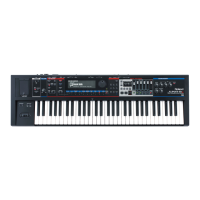56
21: ROTARY
The Rotary eect simulates the sound of the rotary speakers often used with the
electric organs of the past. Since the movement of the high range and low range
rotors can be set independently, the unique type of modulation characteristic of these
speakers can be simulated quite closely. This eect is most suitable for electric organ
Tones.
Rotary
R in
Parameter Value Explanation
Speed #
Simultaneously switch the rotational speed of the low
frequency rotor and high frequency rotor.
SLOW
Slows down the rotation to the
Slow Rate.
FAST
Speeds up the rotation to the
Fast Rate.
Woofer Slow Speed 0.05–10.00 Hz
Slow speed (SLOW) of the low
frequency rotor
Woofer Fast Speed 0.05–10.00 Hz
Fast speed (FAST) of the low
frequency rotor
Woofer Acceleration 0–15
Adjusts the time it takes the
low frequency rotor to reach
the newly selected speed when
switching from fast to slow (or
slow to fast) speed. Lower values
will require longer times.
Woofer Level 0–127
Volume of the low frequency
rotor
Tweeter Slow Speed 0.05–10.00 Hz
Settings of the high frequency
rotor
The parameters are the same as
for the low frequency rotor
Tweeter Fast Speed 0.05–10.00 Hz
Tweeter Acceleration 0–15
Tweeter Level 0–127
Separation 0–127 Spatial dispersion of the sound
Level # 0–127 Output Level
22: VK ROTARY
This type provides modied response for the rotary speaker, with the low end boosted
further.
This eect features the same specications as the VK-7’s built-in rotary speaker.
L out
R out
L in
R in
Rotary
2-Band EQ
2-Band EQ
Parameter Value Explanation
Speed #
Rotational speed of the rotating speaker
SLOW Slow
FAST Fast
Brake # OFF, ON
Switches the rotation of the
rotary speaker.
When this is turned on, the
rotation will gradually stop. When
it is turned o, the rotation will
gradually resume.
Woofer Slow Speed 0.05–10.00 Hz
Low-speed rotation speed of the
woofer
Woofer Fast Speed 0.05–10.00 Hz
High-speed rotation speed of
the woofer
Woofer Trans Up 0–127
Adjusts the rate at which the
woofer rotation speeds up when
the rotation is switched from
SLOW to FAST.
Parameter Value Explanation
Woofer Trans Down 0–127
Adjusts the rate at which the
woofer rotation speeds up when
the rotation is switched from
FAST to SLOW.
Woofer Level 0–127 Volume of the woofer
Tweeter Slow Speed 0.05–10.00 Hz
Settings of the tweeter The
parameters are the same as for
the woofer.
Tweeter Fast Speed 0.05–10.00 Hz
Tweeter Trans Up 0–127
Tweeter Trans Down 0–127
Tweeter Level 0–127
Spread 0–10
Sets the rotary speaker stereo
image. The higher the value set,
the wider the sound is spread
out.
Low Gain -15–+15 dB Gain of the low range
High Gain -15–+15 dB Gain of the high range
Level # 0–127 Output Level
23: CHORUS
This is a stereo chorus. A lter is provided so that you can adjust the timbre of the
chorus sound.
L in
R in
Chorus
Chorus
L out
R out
2-Band
EQ
2-Band
EQ
Balance W
Balance W
Parameter Value Explanation
Filter Type
Type of lter
OFF No lter is used
LPF
Cuts the frequency range above
the Cuto Freq
HPF
Cuts the frequency range below
the Cuto Freq
Cuto Freq 200–8000 Hz
Center frequency when using the
lter to cut a specic frequency
range
Pre Delay 0.0–100 msec
Adjusts the delay time from the
direct sound until the chorus
sound is heard.
Rate # 0.05–10.00 Hz, note Frequency of modulation
Depth 0–127 Depth of modulation
Phase 0–180 deg Spatial spread of the sound
Low Gain -15–+15 dB Gain of the low range
High Gain -15–+15 dB Gain of the high range
Balance # D100:0W–D0:100W
Volume balance between the
direct sound (D) and the chorus
sound (W)
Level 0–127 Output Level

